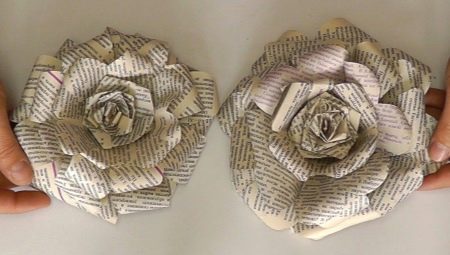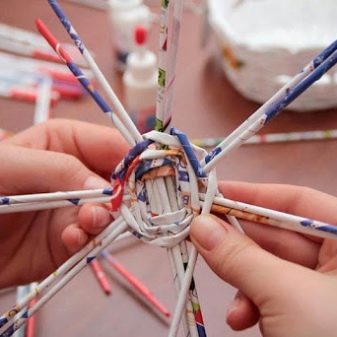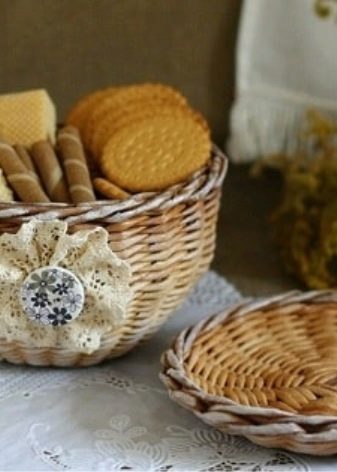We make crafts from newspapers

A stack of newspapers can be found in almost every family. The money has been spent, the newspapers have been read, it’s a pity to throw it away. But the ingenuity of the needlewomen found a use for them. It is enough to recall the old craft of basket weaving or the papier-mâché technique, and products made from old newspapers and magazines will add coziness and individuality to any room.

Options for crafts from newspaper tubes
Weaving handicrafts from newspaper tubes is available not only for adults, but also for children.... The easy-to-use and cheap material makes it possible not only for handicraftsmen, but also for beginners who want to master an unusual craft, but do not have the opportunity to spend a lot of money on it.
Whatever curiosities are created by weaving masters. It can be:
- vases and flowerpots;
- housekeepers;
- dishes and candy bowls;
- napkin holders;
- tea houses and boxes;
- interior dolls.



You can list it endlessly, since there is no limit to imagination.
To create them, needlewomen use different types of weavinggained with experience. But at the master class, you will be told about the simple weaving of a useful item for a beginner - a basket.
At the heart of any weaving from newspaper tubes is the receipt of consumables. For this purpose, newspapers, magazines or consumer paper weighing 45–48 g / m² are suitable. Office paper is not suitable for weaving due to its high density. In addition to paper, you will need a clerical knife, glue stick or PVA and a long thin knitting needle with a diameter of 1 or 1.5 mm.


To roll the tubes, you need:
- cut the newspaper into strips 70-100mm wide, the more massive the craft is, the wider the strips are needed;
- choose the length of the strip so that the finished tube is no more than 400 mm; it is better not to roll the tube along the entire length of the newspaper sheet;
- having spread the strip on the table, you need to lay a knitting needle on its corner at an angle of 30?;
- After slightly moistening your fingertips with water, start winding the newspaper around the knitting needle;
- tightly pressing the strip to the knitting needle, wind the tube, making sure that the paper lies flat, otherwise the product will be loose and sloppy;
- when a small corner remains until the end of the wrapping, you need to grease it with glue and smooth it well.
The tube is ready. You will need a lot of such blanks for the basket, so it's better to wind them with a margin.



Further, the tubes can be left unpainted or painted, for which they are used:
- stain;
- watercolors or gouache paints;
- food dyes or other dyes suitable for the paper of the master's choice.


Having prepared the consumables, you can start weaving the basket. To do this, you will additionally need:
- stationery knife;
- a container with a bottom diameter of 10-12 cm;
- glue;
- impregnation and varnish.


They start weaving the basket from the bottom, for which they take 6 tubes twice. The middle of the workpieces is rolled, making it flatter. Next, the tubes are folded in a cross: on the 6 lower ones (base A) they are laid perpendicular to the 6 upper ones (base B). For better fixation, the intersection is greased with glue.
The resulting cross begins to braid. To do this, one long tube is made from two tubes by the extension method: the end of one workpiece is cut off at an acute angle, greased with glue and inserted into the second roll. The extended tube is bent, just not in the place of gluing, and put on the beam of the base A, tightly leading to the base B.

To form the bottom:
- we circle one ray of the additional tube around the middle, passing it either above or below the sides of the cross;
- the second ray follows, only it passes so that the sides of the cross are covered from both sides;
- having formed 2-3 rows of a circle, the base tubes are divided in pairs and continue to braid several more rows;
- then the base is braided, dividing the tubes one by one until the required bottom diameter is reached (in this case, 10-12 cm).





The next stage is weaving the walls of the basket.... For this, the tubules of the base, which remained free, and two working vines, fixed in two adjacent weaves, are suitable. Next you need:
- in the center of the weaving, place a container that is suitable in diameter;
- bend the base tubes around the container, slightly stretching the folds;
- with working vines, continue weaving, alternating one tube at a time, throughout the entire work, you should monitor the distance between the racks and the density of the weaving;
- braid the base until the required height is reached, gradually increasing the length of the working vine;
- then the container needs to be removed, and the edge of the basket should be arranged, for this, the free ends are slightly softened and tucked into the weaving, leading to the next rack, for better fixation, the junction of the rack and the working vine is lubricated with glue;





After that, the structures are allowed to dry and the remaining ends are cut off, the basket is ready.



The finished product can be painted using wood stain and varnish.
Painted and varnished finished products are resistant to abrasion, therefore they are suitable for use in everyday life.



Using papier-mâché
In addition to weaving, newspapers can be used to make papier-mâché crafts. A low-cost and interesting way to diversify the family's leisure with the opportunity to get a unique interior craft.
The easiest papier-mâché method requires newspapers, plasticine and paste.
- The paste is easy to make from a couple of tablespoons of flour and boiling water. Stir the mixture and bring sour cream to a consistency, making sure that there are no lumps.
- The newspaper needs to be torn into small pieces. To do this, you can attract children, let them develop fine motor skills.
- Next, we blind the conceived figure from plasticine and glue it with newspaper scraps in 5-6 layers, smearing each layer with paste.
- Let the workpiece dry well and remove the plasticine by cutting the figure in half.
- Glue the halves together. We decorate the resulting figurine with gouache or water-based paint and varnish.


How to make garlands with your own hands?
Many are familiar with the situation when you need to decorate the house for the holiday, but you don’t want to buy garlands. A creative garland of newspapers can help out here, the size and shape of which depends only on the imagination of the creator.
The simplest garland will be made of hearts made from strips of paper and strung on a string. You can use jute or colored thread as a rope.
To make such a garland, you need to cut narrow strips of different lengths from the newspaper. Then we will form a heart from the strip, into which we will insert a couple of smaller ones. Glue a loop to the heart and fasten it to the rope. We will repeat the manipulation several times until the garland reaches the desired length.

You can cut various symmetrical figures from newspaper and glue them in pairs, laying a thread in the center. These can be butterflies, stars, circles, and the like.


More complex garlands are obtained by gluing several figures together to obtain a three-dimensional structure. For example, in order to make a three-dimensional asterisk, you need:
- cut from 3 to 6 identical stars;
- bend the workpieces in half;
- glue them together so that you get a three-dimensional figure;
- glue a loop to one of the rays or stretch a thread through the center of the figure.
So the garland of 3D figures is ready.

More ideas
In addition to the methods listed above, there are other ideas for crafts from old newspapers.
From the newspapers rolled into tubes and cut into short segments, you can make a beautiful panel by sticking them according to the drawing. The finished panel is painted or left as it is. The craft is varnished. It turns out a beautiful interior composition that can be hung on the wall or presented as a gift.

Creative round chandelier it will turn out from circles glued together, cut from newspapers or magazines.

Flowers the house will always be in place, even made from an old newspaper. A bouquet of unusual roses will decorate the living room or bedroom.

Cheerful multicolored hot coastersmade using the quilling technique from newspaper tubes will decorate the dining table for a friendly family.


Dish or bowl, made using the papier-mâché technique, are suitable for putting fruits or sweets on the table.


There are many options for crafts. The ability to create a miracle from seemingly useless material is limited only by the imagination of the creator. And joint handicraft leads to better understanding and brings zest to everyday life.
How to make a vase from newspaper tubes, see the next video.








